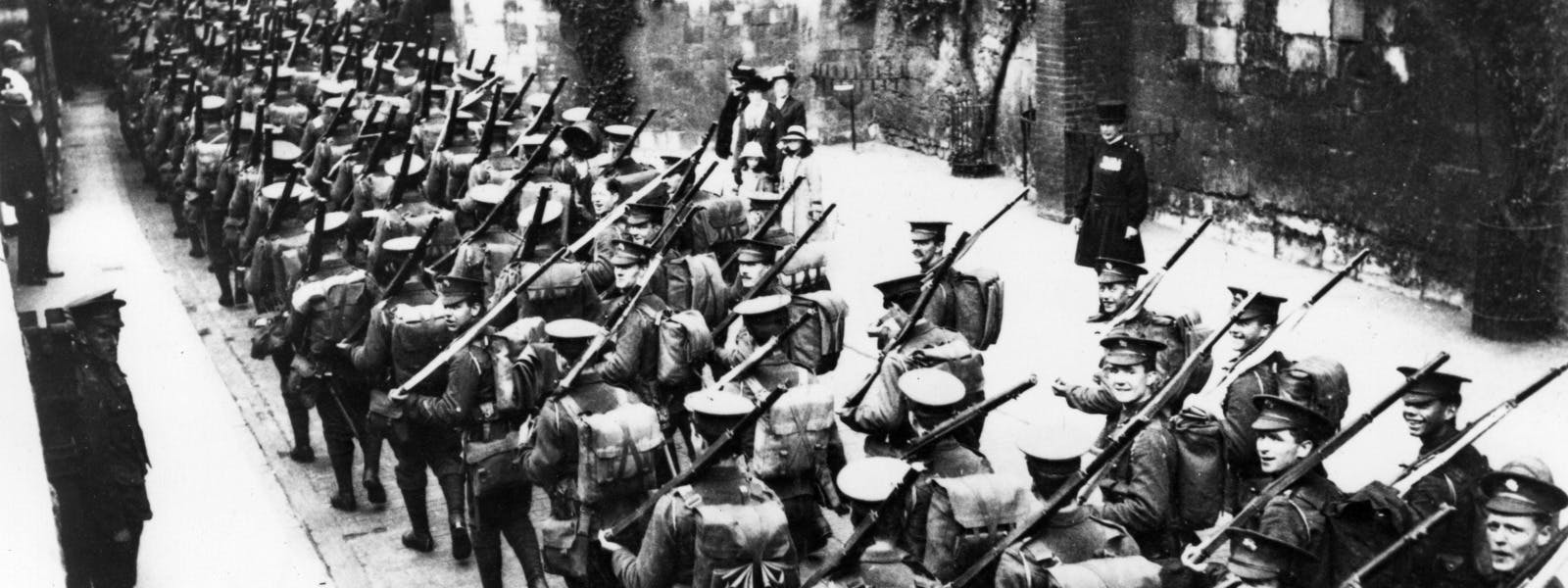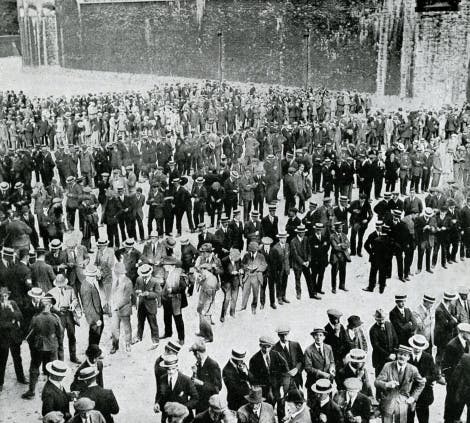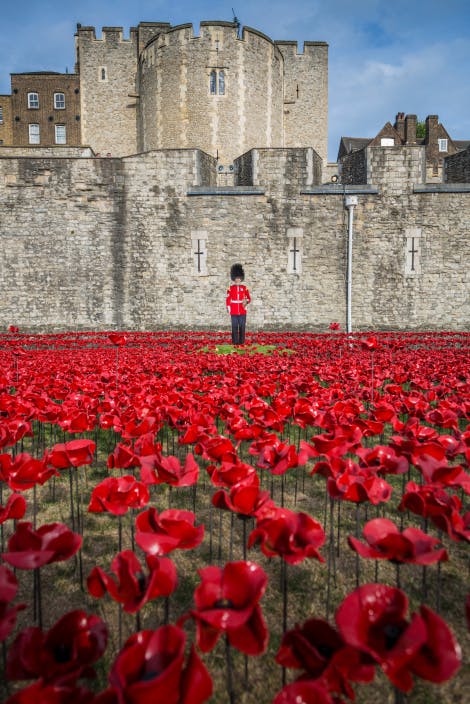
The Tower of London played an important role in the First World War, also known as World War One and the Great War. This devastating conflict re-emphasised the Tower's role as a military store, barracks, and prison.
First World War recruits were trained in the Tower moat, including the Royal Fusiliers (whose headquarters and museum remains at the Tower of London today). The Tower was also, once more, a place of execution for enemies of the State. Between 1914 and 1916, 11 spies were executed within the Tower's walls.

Image: City of London recruits in the moat at the Tower of London. © Illustrated London News Ltd/Mary Evans
The Tower recruits Londoners for war
On 4 August 1914, Great Britain had entered the First World War. Within days of the announcement, young men who worked in the City of London, near the Tower, answered the call to enlist.
Some formed volunteer brigades with friends or work colleagues. 1,300 men who worked for city firms joined the City of London Battalion in the Tower Moat, where they swore the oath of allegiance.

Image: Second Battalion Scots Guards leaving Tower of London for the Front Line. © Chronicle / Alamy Stock Photo
Marching out to the front line
By the beginning of the First World War, the Tower of London had welcomed visitors as a tourist attraction for hundreds of years, but the fortress had never formally dissolved its function as a garrison, prison and execution site. The fortress actively carried out all three roles during the war, even as it remained open to visitors.
Armed forces were positioned around the country and soldiers were garrisoned at the Tower of London, awaiting deployment. The Tower of London was a natural rallying point for the recruitment and training of soldiers and thousands were stationed there during the war.

Image: Personnel of the Tower Bridge Gun Station, London, after the Armistice of 11 November 1918. © Imperial War Museum
Air raids near the Tower
The First World War was the first time aerial warfare had been used on a civilian population, as Zeppelins and other balloons concentrated their bombing raids on cities like London and Hull. During one raid of June 1917, a bomb landed in the moat, narrowly missing the north-east corner of the Tower.
New tactics had to be developed to counter this innovative form of warfare: street lights were dimmed and guns, observers (lookouts responsible for spotting enemy planes), searchlights, and even aeroplanes were mobilised to tackle the high-level threat from above.
Anti-aircraft guns were mounted on Tower Bridge, Gresham College, and Cannon Street Station. They were operated by members of the Royal Marines, Royal Artillery, and the Royal Naval Volunteer Reserve. The latter included Charles ffoulkes (spelled with two lower-case fs), Curator of the Tower Armouries.
This was the first time civilians would use the underground stations for shelter too – a foretelling of more to come during the Blitz in the Second World War.
London had not in those days developed war mentality, and in the early raids everyone came out into the streets to see what was happening; with the result that many were killed...
Charles ffoulkes, Curator of the Tower Armouries, writing about his time in the Royal Naval Volunteer Reserve.

Image: The Byward Tower (the main entrance to the Tower of London) and part of the South Moat in 1916, painted by William George Storm Jr. © Historic Royal Palaces
The Tower remains open
Despite all this, the Tower of London remained open to the public throughout the war, offering some sense of normality for civilians and soldiers alike. One visitor was Canadian soldier and artist William George Storm Jr, who had moved to London to pursue a career as an artist.
In 1915, Storm enlisted in the Artists Rifles, a London regiment formed in 1860 by a group of painters, architects, poets, sculptors, musicians and actors. Later he was commissioned as a 2nd Lieutenant in the 1/5th Battalion, York and Lancaster Regiment.
Before leaving for the Western Front, Storm visited the Tower of London and Hampton Court Palace. During these visits, he made beautiful oil paintings, capturing how people tried to continue with their lives despite the war.
Sadly, Storm would later be killed at the Battle of Passchendaele, in 1917. His painting of the Byward Tower survives as a record of visitors seeking comfort and hope at the Tower during the war.
Spies at the Tower
Almost as soon as war was declared, enemy agents began to enter Britain. What is remarkable about their stories is how little training they received before being sent to carry out acts of espionage. Many were captured easily.
In 1915, the British Army Head Quarters for the London District wrote to the Tower Constable suggesting that the execution of spies in the fortress would have 'more effect on the country at large and, possibly in Germany than an ordinary prison would have'.
By 1916, 11 spies had been executed by firing squad at the Tower of London.
Did you know?
A court martial is a judicial court used for trying members of the armed services accused of breaking military law.

Image: Photograph of Carl Hans Lody, circa 1914. © Alamy Stock Photo
Carl Hans Lody
The first spy executed at the Tower of London
Carl Hans Lody was one of the first prisoners of war, and the first spy, to be held and executed at the Tower of London. Lody, a German naval officer, arrived in Britain at the outbreak of the war in the summer of 1914. He was part of a network of spies sent to strategic positions around the country.
A fluent English speaker, Lody posed as an American. He made his way to Scotland, under orders to observe and gather information on a fleet of warships anchored at Rosyth, a Royal Navy base near Edinburgh.
Lody admitted he felt 'uneasy' and that he was 'not a fit man for that kind of job'. He was well-known to many people internationally from his time escorting tourists on the Hamburg-America shipping line before the outbreak of war.
With no formal training, Lody was unprepared for a life of espionage, and MI5 quickly uncovered his true identity. He was captured and brought back to London to be tried by court martial. Lody was charged with war treason, defined as giving aid or comfort to the sovereign's enemies in wartime. This was unusual for espionage cases at this time.
Carl Hans Lody on trial
Lody's court martial took place at the Middlesex Guildhall in Westminster, London on 30 October and lasted until 2 November 1914. During his trial, it was said that Lody looked more like a clerk than a dangerous spy.
When the court asked, 'Who sent you to England?', Lody hesitated and went pale. He had pledged his word of honour and refused to reveal who had sent him.
On the final day of court, he was found guilty and sentenced to death.
Imprisoned at the Tower
Lody was held in Wellington Barracks, near Westminster, before and during his trial. After his conviction, the Major of the Tower of London was informed there was very little time to prepare and secretly carry out the sentence.
The War Office approved the Tower of London as the location for Lody's execution. The date was set for the morning of 6 November 1914. Three days later, Lody was taken to the Tower.
Convicted and condemned, Lody wrote a letter to the Commanding Officer of the 3rd Battalion Grenadier Guards expressing his 'sincere thanks and appreciation towards the staff of officers and men' who treated him kindly during his imprisonment at the Wellington Barracks. He also wrote to his family.

Image: Carl Hans Lody. © The British Library Board, 010705.i.35
My dear ones... Tomorrow I shall be shot here in the Tower. I have had just judges, and I shall die as an officer, not a spy. Farewell. God bless you, Hans.
Lody's final letter to his family

Image: No.29 Casemates, where Lody was imprisoned at the Tower. From 'Shot in the Tower: The Story of the Spies Executed in the Tower of London During the First World War' by Leonard Sellers (Pen and Sword Books).
Lody's final walk
On the morning of Lody's execution, as an officer led him away from his cell, he asked, 'I suppose that you will not shake hands with a German spy?'
The officer replied, 'No. But I will shake hands with a brave man.'
The Tower Chaplain read the burial service, leading a calm and composed Lody through the Tower. Armed escorts and the guards, who were to carry out his sentence, followed closely behind.

Image: Yeoman Warder John Fraser RVM. © Historic Royal Palaces / Yeoman Warder Archive
A Yeoman Gaoler witnesses Lody's execution
In his memoir, Sixty Years in Uniform, published in 1939, Yeoman Gaoler John Fraser recalled Lody's final moments before his execution.
'The Chaplain, in his nervousness, made to turn left, which was the wrong way. Instantly Lody took a quick step forward, caught the Chaplain by the right arm, and, with a polite and kindly smile, gently guided him to the right – the correct way...
A few moments later the procession disappeared through the doorway of the sinister shed, and shortly after that came the muffled sound of a single volley.'
Carl Lody was executed in the miniature rifle range of the Tower of London in the morning on 6 November 1914. He was 37 years old.

Image: The 'sinister shed', known as the miniature rifle range, at the Tower of London where Carl Hans Lody was executed. The range was used to practise ranging rifles - calibrating sights - and general weapons training. Image: © Imperial War Museum IWM (Q 36444)
Carl Hans Lody's burial in East London
After Lody's execution, the Tower opened its doors to visitors the same day. During his trial, Lody had written to a friend that his 'body shall have been placed in the concrete beneath this old Tower'. In fact, Lody was buried in an unmarked common grave in East London Cemetery in Plaistow.
Sometime after, the War Graves Commission erected a wooden cross on Lody's grave and his family added a white headstone. The headstone was destroyed by bombing during the war, but was replaced by his relatives in 1974.
The War Graves Commission and the German Embassy created a memorial for German civilians buried in the cemetery, including other spies executed at the Tower. A small stone marks their resting place.
The First World War spies executed at the Tower
After Lody’s execution, 10 spies were at the Tower from 1915 to 1916. The spies were of various nationalities, including German, Swedish, Uruguayan and Brazilian. They were:
- Carl Frederick Muller, executed 23 June 1915
- Haicke Petrus Marinus Janssen and Willem Johannes Roos, executed 30 July 1915
- Ernst Waldemar Melin, executed 10 September 1915
- Augusto Alfredo Roggen, executed 17 September 1915
- Fernando Buschmann, executed 19 October 1915
- George Traugott Breeckow, executed 26 October 1915
- ‘Irving Guy Ries’, executed 27 October 1915
- Albert Meyer, executed 2 December 1915
- Ludovico Hurwitz-y-Zender, executed 11 April 1916

Image: Yeoman Warder Moira Cameron fulfilling her ceremonial duty at the 'Beyond the Deepening Shadow' public event. © Historic Royal Palaces
The Tower remembers
In 2014 the Tower of London marked the centenary of the outbreak of The First World War with the commemorative art installation Blood Swept Lands and Seas of Red, which saw the moat filled with thousands of ceramic poppies.
Inside the Tower, a panel commemorating the spies executed between 1914-1916 and, later in 1941 during the Second World War, was installed along the Battlements between Martin Tower and Constable Tower, in view of where the rifle range once existed.
In 2018 the Tower once again became a site of commemoration, marking 100 years since the end of the First World War with Beyond the Deepening Shadow.
The nightly candle-lighting ceremony in the moat was led by the Yeoman Warders. It created a circle of light radiating from the Tower as a symbol of remembrance.
The First World War and our palaces

The Indian Army at Hampton Court Palace in 1919
In late July 1919, Hampton Court was the scene of one of the most extraordinary but forgotten visits to our palaces.
Browse more history and stories

Tower of London remembers
First World War centenary commemorations at the Tower of London

The Tower of London and the Second World War
Life at the Tower of London during the Second World War

9 surprising facts about the Tower of London Moat
The Tower of London Moat wasn’t always the dry ditch that it is today. Did you know it was once filled with fish? Or that it has been used as an allotment? Here are 9 surprising facts about the moat at the Tower of London.
Explore what's on

- For members
- Events
Members-only Ceremony of the Keys
Members-only access to the traditional locking up of the Tower of London, the Ceremony of the Keys.
-
18 January, 08 February, 22 March 2026
- 21:30
- Tower of London
- Separate ticket (advance booking required)

- Things to see
Torture at the Tower exhibition
Discover stories of the unfortunate prisoners who were tortured within the walls of the Tower of London.
- Open
- Tower of London
- Included in palace admission (Members go free)

- Things to see
Imprisonment at the Tower exhibition
Learn why people ended up as prisoners in the Tower of London, in the very rooms where some of them were held.
- Open
- Tower of London
- Included in palace admission (Members go free)
Shop online

Shop Kings & Queens of England
Discover our informative and best selling range, inspired by the incredible history of the Kings and Queens of England.
From £4.99

Shop Ravens
It is said that if the six ravens were ever to leave the Tower of London then the Tower and the kingdom will fall. Naturally, to preserve the kingdom six ravens are kept to live and protect the Tower of London.
From £2.50

Shop Crown Jewels
For centuries, the Tower of London has safeguarded and showcased the illustrious Crown Jewels, discover our range inspired by these majestic objects.
From £2.50

